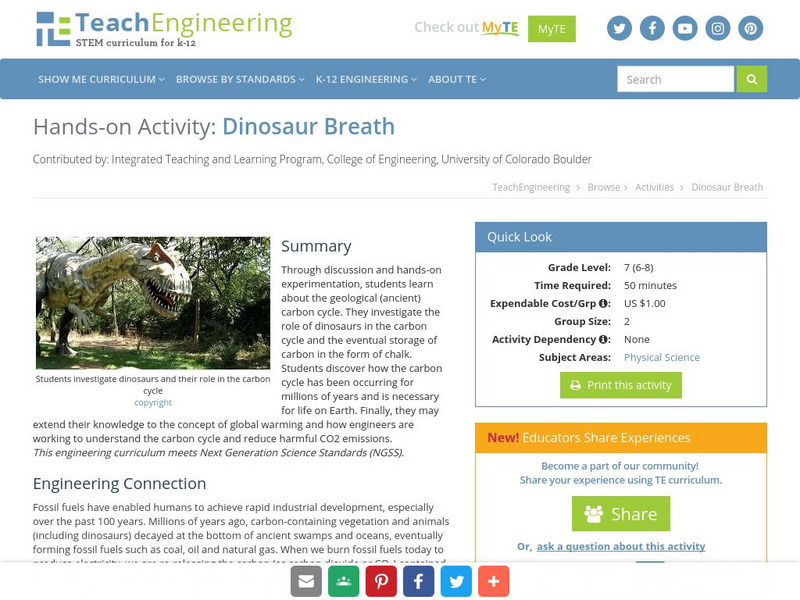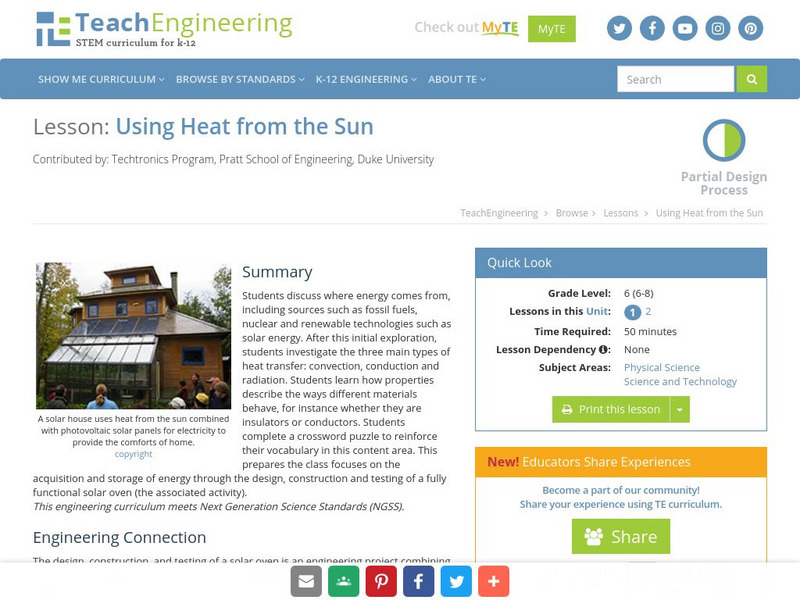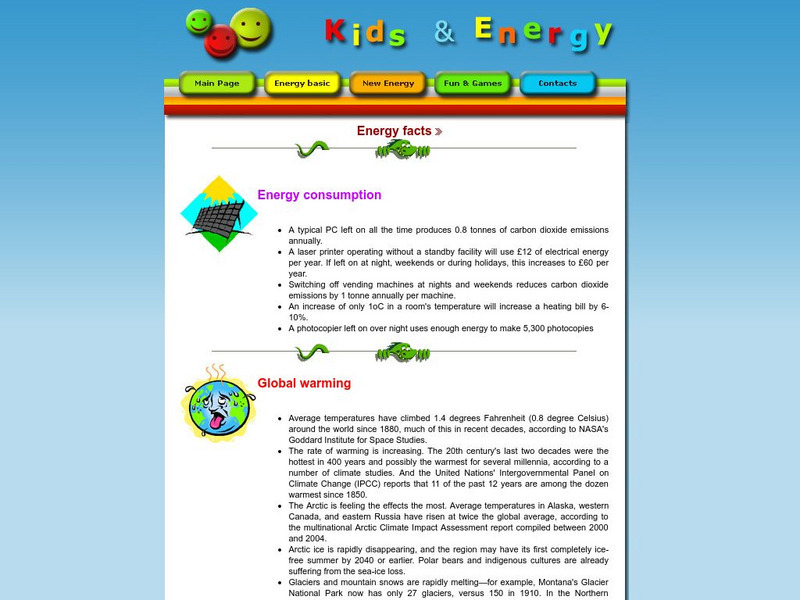TeachEngineering
Teach Engineering: Dinosaur Breath
Through discussion and hands-on experimentation, students learn about the geological (ancient) carbon cycle. They investigate the role of dinosaurs in the carbon cycle and the eventual storage of carbon in the form of chalk. Students...
TeachEngineering
Teach Engineering: Rolling Blackouts & Environmental Impact
The goal is for the students to understand the environmental design considerations required when generating electricity. The electric power that we use every day at home and work is generated by a variety of power plants. Power plants...
TeachEngineering
Teach Engineering: Using Heat From the Sun
In this lesson, students will first discuss where energy comes from, including sources such as fossil fuels, nuclear, and such renewable technologies as solar. After this initial exploration, students will investigate the three main...
Annenberg Foundation
Annenberg Learner: The Habitable Planet: Energy Challenges
With this resource, users join investigators in the exploration of humans' use of and dependence on the many energy resources. Learn about new technologies such as carbon capture and sequestration as an alternative to reduce our carbon...
US Energy Information Administration
U.s. Eia Energy Kids: Nonrenewable Oil (Petroleum)
Provides good information about oil made from petroleum. Covers production, offshore drilling, fuel products made from crude oil, the refining process, and environmental issues. Includes helpful charts and maps.
PBS
Pbs Learning Media: Global Warming: Graphs Tell the Story
Examine these graphs from the NOVA/ FRONTLINE Web site to see dramatic increases in the temperature of Earth's surface and greenhouse gases in the atmosphere.
University of Oregon
Museum of Natural and Cultural History: Rocks and Minerals: Everyday Uses
Click on the shelves in this virtual exhibition to learn about the many rocks and minerals that we use in our everyday lives.
Other
Wbur: New England's Electric Power Grid Is Undergoing a Transformation
This article discusses New England's developing hybrid power grid, a network that relies on a variety of energy resources, including fuels and alternative energy sources and technologies. The ongoing transformation to renewable energy is...
US Department of Energy
U.s. Department of Energy: Coal: Our Most Abundant Fuel
The U.S. has enough coal to last for the next 200-300 years. So why are we not using more of it? This article describes the different types or "ranks" of coal, the history, and the problems with burning coal for energy.
National Geographic
National Geographic: Encyclopedic Entry: Non Renewable Energy
A good primer on non-renewable energy sources. Covers the overall advantages and disadvantages, and discusses the different types and their pros and cons. Includes a slideshow with captions.
National Geographic
National Geographic: Evaluating Other Energy Sources
A comprehensive lesson where students examine the different costs and benefits associated with renewable and nonrenewable sources of electricity. Includes a 22-question interactive module where they look at real-world data and images...
Science Museum, London
Science Museum: Climate Science Info Zone
Media-rich interactive explores Earth's climate, investigating what might be causing the climate to change and how to prepare for it in the future.
PBS
Pbs Learning Media: Global Warming: Beyond Fossil Fuels
Martin Hoffert, professor of physics at New York University, discusses global warming and alternative energies in this interview from the NOVA/FRONTLINE: "What's Up with the Weather?"
Other
Institute for Energy Research: Fossil Fuels
A detailed article providing information about fossil fuel resources in the United States and how they impact economic growth. Several reports, which can be downloaded, examine energy policies, the potential for economic growth, and...
PBS
Pbs Learning Media: Deciding Your City's Energy Future
Students learn about fossil fuels and renewable energy sources to help them decide which type of energy should be used to power a city's electric grid in the coming decades.
Khan Academy
Khan Academy: The Industial Revolution
At one time, humans, fueled by the animals and plants they ate and the wood they burned, or aided by their domesticated animals, provided most of the energy in use. All life operated within the fairly immediate flow of energy from the...
eSchool Today
E School Today: Non Renewable Energy
Learn what non-renewable energy is and the different types.
National Academies of Sciences, Engineering, and Medicine
The National Academies: Our Energy Sources: Fossil Fuels
An overview of fossil fuels used in the United States. Coal, oil and natural gas are listed with information about each energy source.
USA Today
Usa Today: Workers Adjust Habits to Save on Gas Costs
This article focuses on the impact on higher gas costs on workers and companies.
Alberta Online Encyclopedia
Alberta Online Encyclopedia: Canada's Petroleum Heritage
Canada's Petroleum Heritage website is a learning resource that presents the oil and gas industry from past to present. Its rich history, the challenges it faces today and its future potential are explored. The site showcases the people,...
Cynthia J. O'Hora
Mrs. O's House: Crude Oil Is Used for More Than Just Gasoline
Evaluate how much of our day-to-day living depends on products made from crude oil. This activity will explore many of these items and consider the benefits if alternatives were found.
US Energy Information Administration
Energy Information Administration: Country Analysis Brief
Contains briefs with a narrative section, a map showing the country's location, and a section listing pertinent economic and energy data for every country in the world of interest to energy policy makers.
Energy for Sustainable Development
Esd Bulgaria: Kids & Energy: Energy Facts
A collection of facts about energy use broken down into various topic areas, e.g., health impact of fossil fuels, transportation, energy consumption, alternative energies, etc.
BBC
Bbc: News: Guide to Climate Change
The BBC offers an interactive guide to climate change, including a sliding scale depicting climate change from 1885 to 2099, animation which explores how the greenhouse effect works, and detailed diagrams exploring the carbon cycle, the...



















